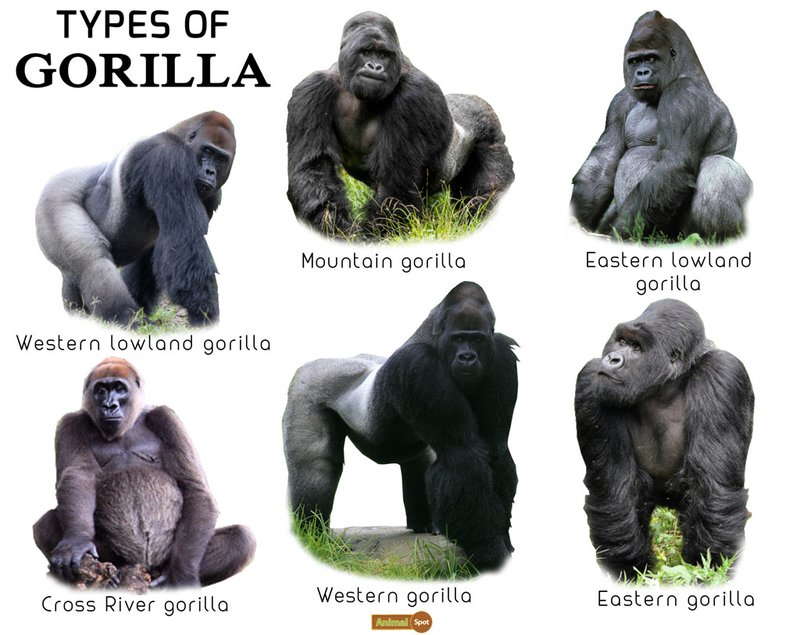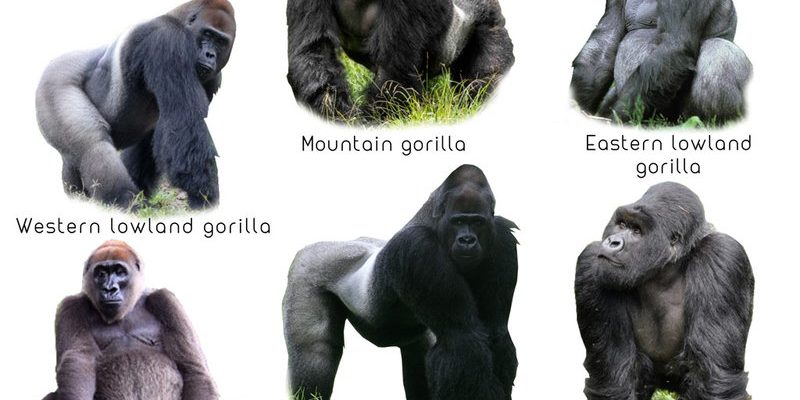
In this article, let’s dive into the world of animals that are similar to the Western Gorilla. We’ll explore their characteristics, habitats, and how to tell them apart. Think of this as your personalized guide to understanding not just gorillas, but their distant relatives and friends in the animal kingdom. So grab a cup of coffee, and let’s get started!
1. Eastern Gorilla
The Eastern Gorilla is often considered the closest relative to the Western Gorilla. Just like siblings, they share a lot of similarities but also have their differences. Eastern Gorillas are larger and can be found in two subspecies: the mountain gorilla and the eastern lowland gorilla.
What to Look For:
– Size: Eastern Gorillas can weigh up to 400 pounds, making them heavier than their Western counterparts.
– Habitat: They thrive in the dense forests of the Virunga Mountains or the lowland forests of the eastern Democratic Republic of the Congo.
– Physical Features: Look for a broader face and denser fur, especially in mountain gorillas, who need it to stay warm in cooler climates.
You might be wondering how to spot them in the wild. Just think of Eastern Gorillas as the “big brothers” of the Western Gorilla, slightly bulkier and found in different terrains.
2. Chimpanzee
Chimpanzees are another close relative of the Western Gorilla. While they are smaller and leaner, they share about 98% of their DNA with humans—pretty impressive, right?
Key Differences:
– Size: Adult male chimpanzees usually weigh between 70 to 130 pounds.
– Behavior: Chimpanzees are known for their playful and social nature. They live in communities and can often be seen engaging in teamwork.
– Physical Appearance: Unlike gorillas, chimps have longer arms and are more agile climbers. Their facial features are less pronounced, giving them a different look.
Imagine meeting a playful cousin who, while not as big as your sibling, steals the show with their acrobatics—that’s the chimpanzee for you!
3. Orangutan
Orangutans are fascinating creatures with a unique lifestyle. While they are not as closely related to the Western Gorilla as chimpanzees are, they still share some common traits.
Identifying Features:
– Size: Adult male orangutans can weigh up to 250 pounds, making them lighter than both gorillas but still hefty.
– Habitat: They are tree-dwellers found primarily in the rainforests of Borneo and Sumatra.
– Physical Attributes: Their long arms and reddish-brown hair distinguish them. They have a more rounded face compared to gorillas.
Think of orangutans as the “tree-huggers” of the ape family—spending most of their time in the treetops and showing incredible intelligence in their tool use.
4. Bonobo
Bonobos are often called the “peaceful apes” and share a lot in common with chimpanzees, though they’re less aggressive. They are another fascinating cousin to the Western Gorilla.
What Makes Them Unique:
– Size: Bonobos are smaller than Western Gorillas, typically weighing around 70 to 130 pounds.
– Social Structure: They have a matriarchal society, with females playing a central role in group dynamics.
– Physical Traits: Bonobos have darker faces and are known for their slender bodies and long limbs.
If you think of chimpanzees as the playful siblings, bonobos might be the diplomatic friends who keep the peace!
5. Gibbon
Gibbons are lesser apes known for their acrobatic skills. While they aren’t closely related to gorillas, they share some physical traits due to being part of the ape family.
Spotting Gibbons:
– Size: Gibbons are much smaller, usually weighing between 15 to 25 pounds.
– Habitat: They are found in the forests of Southeast Asia and are known for their loud calls.
– Features: Gibbons have long arms, which help them swing through trees. Their faces can be more expressive compared to gorillas.
Think of gibbons as the agile gymnasts of the ape world—swinging through foliage like they’re in their own circus!
6. Siamang
The siamang is a type of gibbon that’s a bit larger and has a unique vocalization. They’re known for their distinctive throat sac, which helps amplify their calls.
How to Distinguish Siamangs:
– Size: They can weigh up to 30 pounds, making them slightly larger than typical gibbons.
– Vocalization: Siamangs produce a deep, resonating call that can be heard from miles away.
– Physical Traits: They have a unique black fur and a feature that separates them from other gibbons—the throat sac.
Imagine a talented singer who draws everyone’s attention with their booming voice—that’s the siamang for you!
7. Macaque
Macaques are a diverse group of primates that exhibit a range of behaviors and habitats. While they aren’t as closely related to gorillas, they are fascinating in their own right.
Identifying Macaques:
– Size: They vary greatly, with some species weighing as little as 10 pounds and others up to 60 pounds.
– Habitat: Macaques are found in a range of environments, from snowy mountains to tropical forests.
– Physical Features: They have short tails and a variety of fur colors, depending on the species.
Think of macaques as the adventurous members of the primate family, always exploring and often getting into mischief!
8. Humans
Last but not least, let’s not forget humans! We share a significant amount of DNA with gorillas, making us their distant relatives.
What to Consider:
– Size: On average, adult humans weigh anywhere from 100 to 200 pounds, depending on various factors.
– Social Structures: Humans have developed complex societies and cultures.
– Intelligence: While gorillas show remarkable intelligence, humans have developed advanced tools and technology.
It’s a bit humbling to think about how connected we are to other members of the ape family, right? We share traits that remind us of our shared ancestry.
Exploring the world of animals similar to the Western Gorilla reveals a rich tapestry of life in the animal kingdom. From the majestic Eastern Gorilla to the clever Chimpanzee, each animal plays a unique role in the ecosystem. Understanding these differences not only deepens our appreciation for wildlife but also highlights the importance of conservation efforts.
So, whether you’re gazing at a playful orangutan or marveling at a siamang’s song in the trees, remember that every creature has a story to tell. Let’s cherish our connections with these amazing animals and work towards protecting their habitats. After all, they’re not just distant relatives—they’re vital members of our planet’s family!

